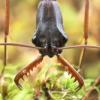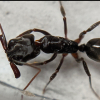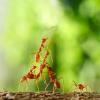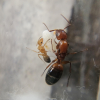Scientific Name: Camponotus floridanus
Common Name: Florida Carpenter Ant, Bulldog Ant, or Tree Ant.
Distribution: Southeastern United States. Very abundant throughout the state of Florida.
Queen size: 15-19 mm
Worker size: Minor Worker 5.5-7 mm. Major Worker 8-11 mm. Workers are polymorphic in this species
Natural Habitat: Nests are found in both disturbed and undisturbed areas. Commonly found within rotting tree stumps, logs, and branches. They are also found among damaged structures and around houses.
Circadian Activity: Primarily a nocturnal species. Have been found foraging during daylight hours.
Mating Flight: Nuptial flights begin from May-August during the late evening into the night. Occurs on warm nights after a good rainfall. Mating takes place while in flight.
Queen Founding Method: Fully Claustral
Monogyne or Polygyne: Strictly Monogyne
Average time from egg to worker: 60 days (give or take) is a rough estimate for entire process from egg to adult. When the temperature is optimally warmer, it can greatly reduce the amount of time it takes from egg to adult.
Egg to larvae: 15-25 days
Larvae to pupae: 7-15 days
Pupae to adult: 14-22 days
Recommended Temperature: 75-85 degrees farenheit. 23-29 degrees celsius.
This is a sub-tropical ant species that like heat. An overhead heat lamp or reptile heating cable would be a good method for this species. don't place a heat lamp to close above your nest, or you can end up killing the colony. One side of the nest should receive heat, while the other side should be much cooler. This gives them the option to move back and forth as needed.
Recommended Humidity: Humidity is required for this species to stay hydrated, and to expose their brood to moisture when needed. A water tower and/or nestmate will be sufficient for them. They generally prefer a dry nest with some portions exposed to higher humidity levels. Extremely high levels of humidity and heat will kill them.
Preferred Foods: Protein sources include living or dead insects such as cockroaches, crickets, superworms, mealworms, fruit flies, pheonix worms, moths, and grasshoppers. Cooked and softened chicken, beef, or shrimp can also be used. Carbohydrate sources include yogurts, sugar water, honey, maple syrup, strawberry milk syrup, softened fruit, cookie pieces, donut pieces, and candies.
Camponotus floridanus possess two stomachs. One stomach is used for themselves and the other is used as a social stomach. The social stomach's function is to share food with the queen, colony nestmates, and their larvae. These ants empty their social stomach when feeding others, and can refill it when needed.
Hibernation Details: This species does not require a hibernation period or a lengthy diapause. When temperatures outside reach anywhere from 50-68 degrees (farenheit), they will slow down production and growth until temperatures reach 75 degrees or above. I would slowly and carefully cool them to around 66-70 degrees for 14-30 days. This helps simulate the random changes of temperature experienced in Florida. This can increase egg laying, and brood development. Always provide water, and some carbohydrates to keep energy going. After 14-30 days, slowly start to warm the colony back up. (Cooling and warming them rapidly/instantly can cause the ants shock which will kill them).
Escape Barrier Methods: Fluon with talcum powder is effective in their containment. Camponotus floridanus are able to climb just about any surface type.
Difficulty rating: Large and easy starter species for any beginner. This species is slower growing and allows beginners to observe the queen, and watch her brood go through all stages. Patience and understanding will be needed for beginners.
Bite and/or Sting rating: Both minor and major workers are able to bite, causing no pain or a pinching feeling. They can spray formic acid into the bite wound which causes burning, itching, swelling, redness, and pain. Not everyone experiences these symptoms.
Special Care or Interesting Notes: Being large carpenter ants, they can easily chew through soft plastics, wood, plaster of paris, cotton ball plugs, cork material and clay. Since they can utilize formic acid, make sure you have proper ventilation for your colony. This species will also spray small amounts of formic acid inside and outside their nest, which helps not only to cleanse the areas, but helps prevent growth of bacterial, viral, and fungal diseases.
Additional Links:
https://www.antweb.o...e=United States
http://entnemdept.uf...penter_ants.htm
https://www.antwiki....otus_floridanus
Information submitted by LPN1982
- Formiculture.com
- Forums
- Gallery
- Members
- Member Map
- Chat























